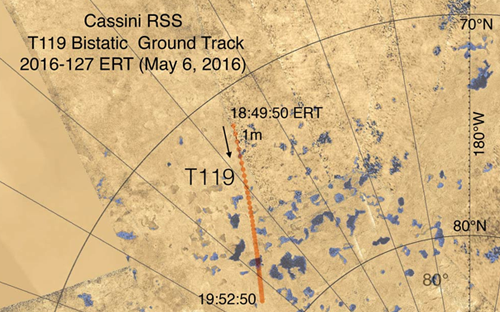During Cassini's T-119 Titan flyby on May 6, the Radio Science Subsystem, or RSS, will observe an atmospheric occultation, in which Cassini appears to go behind Titan's atmosphere as seen from Earth. This is the last RSS Titan occultation in the Cassini mission. The way the atmosphere modifies Cassini's radio signal will be used to profile the thermal structure of the atmosphere and learn more about how it varies with Titan’s seasons. RSS continues with a short bistatic scattering observation, with the radio signal's ground track possibly crossing small lakes on Titan. Data from this observation may yield information about Titan’s surface (including reflectivity, roughness, and dielectric constant) that will improve our understanding of the moon's composition.
Key Points
◆
The T-119 flyby is a unique 'double midnight' flyby, in that it occurs when Titan is on the night side of Saturn and the closest approach by Cassini is on the nightside of Titan as well.
Key Points
◆
Data from this observation may yield information about Titan’s surface that will improve our understanding of the moon's composition.
Scientists have found that Titan’s upper atmosphere and ionosphere change depending on a variety of factors, including Titan’s location in its orbit through Saturn’s magnetosphere, timing with respect to the 11-year solar cycle, and the geometry with respect to Titan and orientation with respect to the Sun of the closest approach. The only way to understand the influence of each of these factors on Titan’s upper atmosphere and ionosphere is to make observations over a wide range of varying geometries.
During the flyby, the Ion and Neutral Mass Spectrometer, or INMS, will make measurements of Titan’s atmosphere when the nightside receives the smallest possible infusion of energy from the sun. This helps scientists understand how the sun drives Titan’s upper atmospheric chemistry, while density observations provide insight on how quickly Titan’s atmosphere responds to inputs, relative to the length of Titan’s day.
The Magnetospheric Imaging Instrument, or MIMI, will measure the energetic ion and electron environment during the flyby. MIMI data will be used to estimate the energetic particle input from the magnetosphere into Titan’s atmosphere and ionosphere. This will help interpret the atmospheric characteristics (the ionization layers and scale heights) observed by RSS. Cassini's observations have demonstrated that the magnetospheric environment near Titan is much more variable and complex than scientists could ever have anticipated.
Titan Flyby at a Glance
Date
May 6, 2016
Altitude
603 mi (971 km)
Speed (relative to Titan)
13,198 mph (5.9 km/sec)

", "credits": "NASA/JPL-Caltech/San Jose State University/Cornell University", "zoom": 0, "fit": "fit", "parallax": "no", "focalPoint": {"x": ".50", "y": ".50"}}, "image_align": "inline", "migrated": true} -->






























